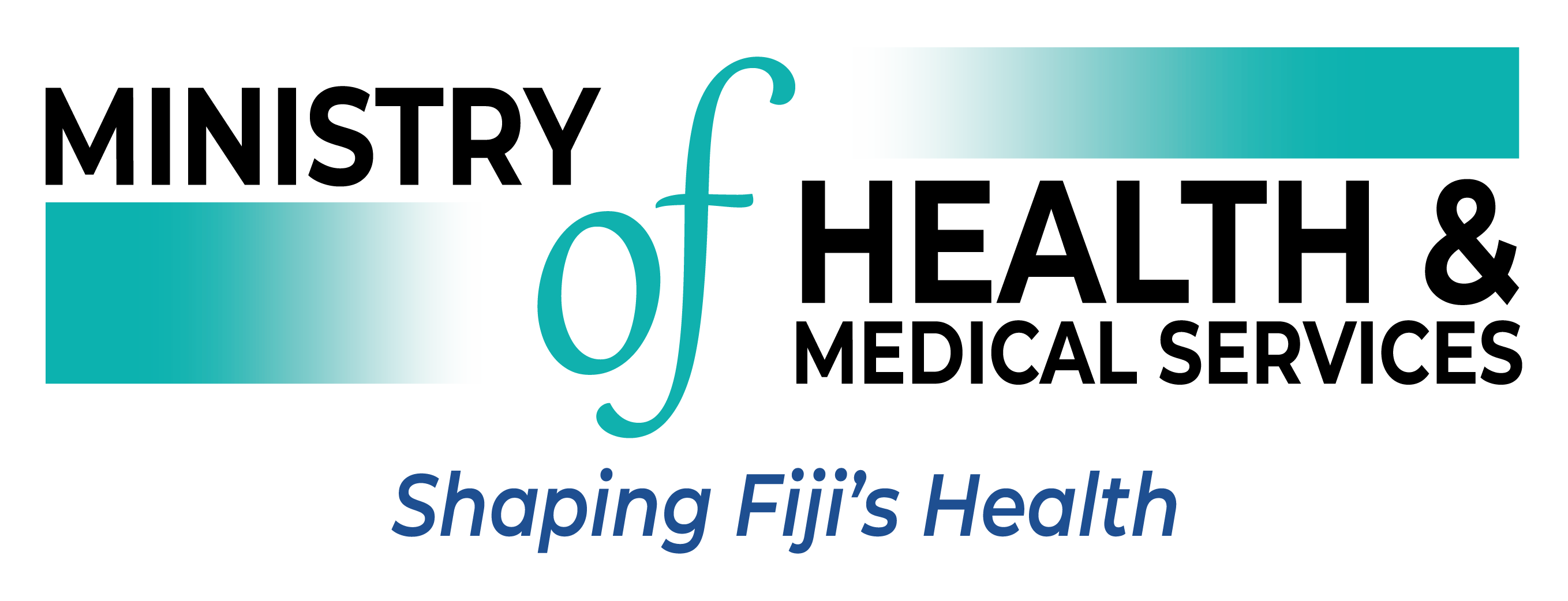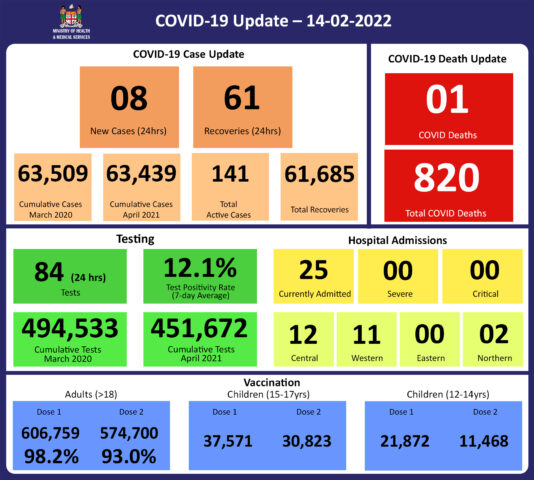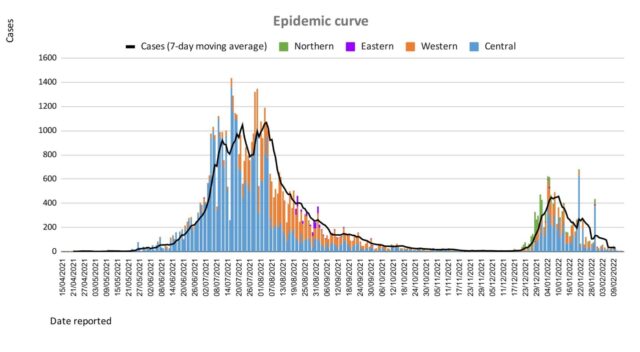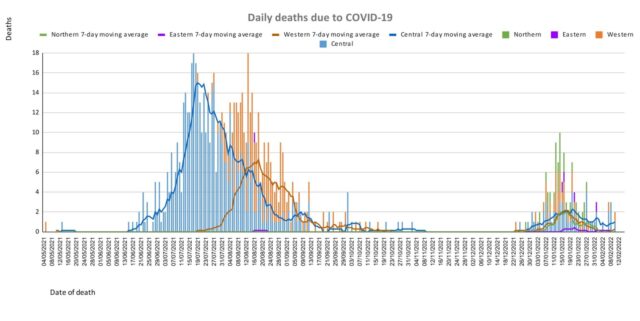COVID-19 Update 14-02-2022
COVID-19 Situation Update
Monday 14th February
| Transmission Update:
Since the last update, we have recorded 60 new cases of which 43 new cases were recorded on 10/02/2022, and 17 new cases in the last 24 hours ending at 8 am this morning. Of the 60 cases recorded, 51 cases were recorded in the Central Division; 8 cases were recorded in the Western Division, 1 case was recorded in the Northern Division, and nil case was recorded in the Eastern Division. Overall, there have been 63,406 cases of COVID-19 recorded in Fiji, with 68% of the cases from the Central Division, 28% of the cases from the Western Division, 1% of the cases from the Eastern Division, and 3% from the Northern Division. The national 7-day rolling average of cases as of 7th February is 34 daily cases. |
||||||||||||||||||||||||||||||||||||||||||||||||||||||||||||||||||||
| Deaths:
The curves depict daily COVID-19 deaths by division since May 2021. It indicates a surge from December-end 2021, which peaks by mid-January 2022. The 3rd COVID 19 wave is considered to have started around mid to late December 2021. (Note: Death notifications from the weeks 27/01/22 onwards are still being received, we are currently on week 12/02/2022, therefore the appearance of a downward trend on the graph from week 27/01/22 may not be accurate. There are deaths from the Western Division currently under investigation for the same time period hence, the death rate for the division may increase). Analysis of Deaths in the Third Wave Table 1: Death rates by Division
An analysis of the 124 deaths recorded in the third wave show that, while the Central Division has the highest absolute number of deaths, the Northern Division has the highest rate of death when adjusted for population. (Note: There are deaths currently being investigated from the Western Division for the same time period, therefore the rate for the division may increase). Table 2: Deaths by Age Group
Table 3: Deaths by Vaccination Status
Out of 124 COVID -19 deaths reported in the third wave, five deaths were in the population not eligible for vaccination (under age 12). An analysis of the 119 deaths in the vaccine-eligible population reflected, that when adjusted per 100,000 population, for fully vaccinated (received 2 doses) and unvaccinated/not fully vaccinated (received 0 doses or only 1 dose) adults in Fiji, a death rate of 8.8 per 100,000 population for fully vaccinated adults and 149.2 for unvaccinated adults was exhibited. This means that unvaccinated adults in Fiji have been dying at a rate 16.9 times higher than fully vaccinated adults during the current COVID-19 wave. Individuals of the 12-17 age group who died were not vaccinated. There have been no COVID-19 deaths in individuals who received a booster (3rd dose) of the vaccine. New deaths to report There is one new COVID-19 death to report. The COVID-19 death to report is of a 91-year-old female from the Central Division, who died at home on 10/02/2022. She was not vaccinated. There has been a total of 820 deaths due to COVID-19 in Fiji. Please note that due to the time required by clinical teams to investigate, classify and report deaths, a 4-day interval is given to calculate the 7 days rolling average of deaths, based on the date of death, to help ensure the data collected is complete before the average is reported. Therefore, as of February 10th, 2022, the national 7 days rolling average for COVID-19 deaths per day is 1.1, with a case fatality rate of 1.29%. We have recorded 861 COVID-19 positive patients who died from other serious medical conditions unrelated to COVID-19; their doctors determined that COVID-19 did not contribute to their deaths, therefore these are not classified as COVID-19 deaths. |
||||||||||||||||||||||||||||||||||||||||||||||||||||||||||||||||||||
| Hospitalization:
There is a sustained downward trend in daily hospitalizations. Using the WHO clinical severity classification, a greater percentage, 72% (n=18) of the admissions of COVID-19 positive patients are categorised as asymptomatic and mild, 8% (n=2) are categorised as moderate and 20% (n=5) as severe with nil case in the critical category. Anyone admitted to the hospital is tested before admission, therefore, a significant number of people are admitted to the hospital for non-covid health conditions, but incidentally, test positive due to the high amount of transmission in the community. The number of people being admitted because of COVID-19 remains low. |
||||||||||||||||||||||||||||||||||||||||||||||||||||||||||||||||||||
| Testing:
84 tests have been reported for February 13th, 2022. Total cumulative tests since 2020 are 494,533 tests. The 7-day daily test average is 161 tests per day or 0.2 tests per 1,000 population. The national 7-day average daily test positivity is 12.1%. The high positivity rate is an indication of widespread community transmission. |
Public Advisory:
Vaccination
Increasing our vaccination coverage for the last 8% of our adult population remains a challenge, despite the increased risk of severe outcomes in this group. While we will continue to do our part to promote and deploy vaccines, community support is necessary to sustain the impact of our efforts especially to the vulnerable within this 10%. We remain gravely concerned that we continue to receive requests for vaccine exemption from persons with medical comorbidities, especially NCDs; their medical condition is an indication for vaccination, and granting the exemption is not an option for any qualified medical person.
During this third wave, unvaccinated deaths in the vaccine-eligible population are occurring at 17 times the rate of vaccinated deaths. This is a strong indication that many of the unvaccinated deaths in the vaccine-eligible population were preventable. I strongly urge anyone who hasn’t been vaccinated to get vaccinated now because COVID-19 is here to stay, and Omicron will not be the last variant. And if you are vaccinated, but know someone who isn’t, please also encourage them to protect themselves by getting vaccinated.
The booster dose program began at the end of November 2021. As of February 14th, 91,414 individuals have so far received booster doses of the Moderna and 60 individuals have received the Pfizer booster COVID-19 vaccine. For the month of February, a further 175,558 have become eligible for booster doses. We are targeting to cover all these eligible individuals in the days ahead. Please come forward to get your booster (3rd dose) vaccine if you are aged 18 or over and it has been at least 5 months since your second dose.
Leptospirosis, typhoid fever, and dengue fever
With the recent heavy rains and flooding in parts of Fiji we anticipate an increase in these endemic climate-sensitive diseases. After the recent floods, we are starting to see more people admitted for leptospirosis into our hospitals in the Western Division and the intensive care unit at Lautoka Hospital.
Since January we have confirmed 74 cases, however, there are many more who were diagnosed clinically. The 3 divisional hospitals have reported 28 admissions with 19 in Lautoka Hospital alone. A total of 11 deaths have been reported, the youngest was 6 years old and the oldest was 56 years, and most of the deaths were in Itaukei males between 16 to 35 years of age. Delay in accessing care has been noted to contribute significantly to these adverse outcomes.
Members of the public must understand that to prevent leptospirosis, one should avoid wading or swimming in flooded waters, wear shoes when walking outside, and keep all food and drinks covered and away from rats.
Also, early treatment can decrease the severity and duration of disease and this entails initiating antibiotic treatment as soon as possible without waiting for laboratory results. With the widespread rain and flooding around the country, the public is requested to please consult a doctor early if you are sick, especially if you have a fever and remain unwell for more than 3 days and don’t seem to be responding to outpatient treatment.
The Ministry of Health and Medical Services has convened the Communicable Disease Committee, which will assist the Divisional Command Centres in responding to cases of leptospirosis, typhoid, and dengue fever, including raising awareness amongst the public and providing refresher training for medical professionals in primary care for early diagnosis and treatment.
Additionally, we have deployed specialist outreach teams to areas that are viewed as difficult to reach and at risk. We have a FEMAT team deployed to Navosa, and a mobile team led by our Hon Minister will visit communities on Kadavu island over the next few days as part of the Ministry’s community engagement strategy.
The Vaccine Plus Approach
We have had inquiries from the public on further relaxation of personal covid safe measures such as masking. As I have mentioned in the past, COVID-19 is not going to have a clean pandemic endpoint where we close off all chains of transmission and drive cases to zero. COVID-19 has an endemic endpoint, and in Fiji, as is with the rest of the world, societies will have to adapt to living alongside COVID-19 by making some deliberate choices about how to coexist.
The endemic disease does not mean unmanaged disease. Our current tracking indicates ongoing consequences especially for the vulnerable in society and the delays in seeking and reaching care is a major factor. We also have the global risk of variants developing elsewhere and spreading to Fiji.
The Vaccines Plus approach is the only means available to us. Until the consequences of COVID-19 are comparable to daily normal risks and the global threat of resurgence is low, the need for masking mandates to facilitate a public health imperative will still be needed.
So, while we have a high level of vaccination we continue to emphasize ventilation, masking, physical distancing, cough/sneeze etiquette, hand washing, and isolating from others if you have symptoms.
Hand washing and cough etiquette are immovable as public health measures. Regular hand sanitization and coughing/sneezing into a tissue or handkerchief, or the bend of your elbow, are healthy habits that protect you and others from COVID-19 and other infectious diseases. Isolating yourself, or staying away from others, when you are sick with any respiratory illness is also a good habit to protect others, especially the vulnerable.
Masking, physical distancing, and ventilation are 3 measures that must constantly be present. When one of the measures becomes difficult to apply, implementation of the other two measures must be further escalated. Whatever the scenario, an effective mask must be kept close by you at all times. The current masking requirement of wearing a mask that covers your nose and mouth is mandatory in all public places for everyone aged 8 and over, including in public service vehicles remains in force. The Ministry of Health and Medical Services is looking into a list of exemption criteria; however, we expect that this list will not be exhaustive and we hope to leave some space for a common-sense approach to evolve.
In a setting where physical distancing of 2 metres is difficult, then increasing ventilation and more strict masking practice will be needed even more. A well-ventilated indoor space refers to an indoor space wherein there is a good movement of outside air coming into the space, and inside air is going out. A poorly ventilated closed space is bad for many reasons aside from COVID-19, however, in this scenario, the physical distancing rules will increase and masking is more necessary.
For custodians of workplaces, houses of worship, and the like, balancing the relationship between ventilation, physical distance, and masking is the only way to ensure that services are COVID safe and can be customized to the principle of living with the virus. SOPs need to be configured to all activities that occur in your work or worship space in order to be COVID safe. We all want to mitigate the risk of unsustainable sick leave levels every time we get a variant, and more variants will come. Mitigating the risk of people getting sick is the best way to reduce further the risk of severe disease and death beyond the protection afforded by vaccination. Promoting good COVID safe principles in a common-sense approach is the best way to start.
Last Updated on 2 years by Publishing Team



